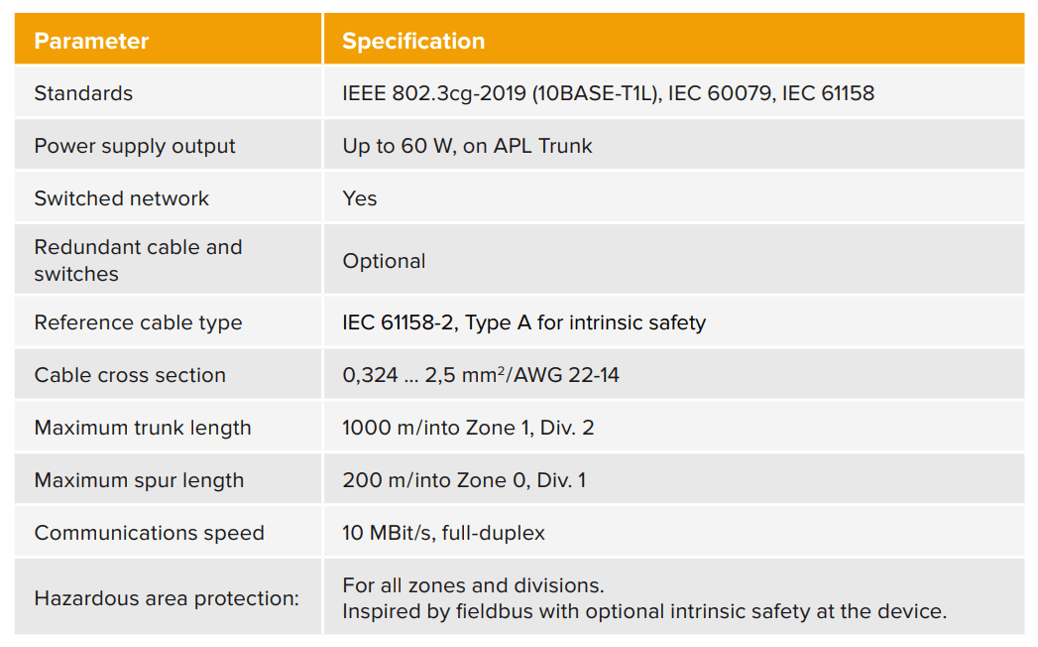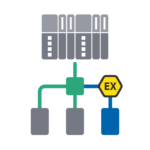Go digital.
Go PROFINET.
The communication standard
for the digital transformation.

Advanced Physical Layer (APL)
Automation networks in the process industries must fulfill many challenging requirements. For example, process applications may demand continuous operation, 24/7 reliability, and the management of hundreds of thousands of signals. Also, hazardous environments are common in the process industries. A hazardous area is any space in which you can expect a flammable/explosive atmosphere. It requires special precautions for operation.
Only intrinsically safe technologies can be landed in a hazardous environment. Ethernet is not intrinsically safe. Therefore, you cannot land an Ethernet cable in a hazardous environment. Intrinsically safe technologies such as PROFIBUS PA, Foundation Fieldbus, Hart, and wireless Hart, are available to establish communication within those hazardous environments. However, there remains a desire to bring Ethernet to field devices in hazardous areas. Taking process industries into the future requires a new network standard to transfer process data with standard Ethernet and IP technologies. Advanced Physical Layer (APL) is an upcoming new technology that will enable intrinsically safe Ethernet.
What is APL?
 APL is a new physical Layer. The goal of APL is to bring Ethernet down to field level instruments in hazardous areas. Ethernet at the field level will make digitalization for process industries a reality. Ethernet adds its universality and speed to existing field device installations.
APL is a new physical Layer. The goal of APL is to bring Ethernet down to field level instruments in hazardous areas. Ethernet at the field level will make digitalization for process industries a reality. Ethernet adds its universality and speed to existing field device installations.
APL will limit current and voltage in the physical Layer to have an intrinsically safe solution for Zones 0 & 1 / Div 1. The physical connection will be a rugged two-wire connection with power over this cable. Finally, APL will exceed the 100 m limit of 100BASE-TX Ethernet networks to be suitable for large process manufacturing facilities. Currently, APL is not available. But work is proceeding quickly on this exciting technology.
APL in Industrial Automation
The agreement to develop the Ethernet-APL technology under “The APL Project” was established in 2018 and is backed by the leading industry standard development organizations (SDOs) FieldComm Group, ODVA, OPC Foundation, and PROFIBUS & PROFINET International, as well as by major industry suppliers of process automation, including ABB, Emerson, Endress+Hauser, Krohne, Pepperl+Fuchs, Phoenix Contact, R. Stahl, Rockwell Automation,
Samson, Siemens, Vega, and Yokogawa. APL's goal is to meet the needs of the process control industry with:
- Limited current/voltage to be intrinsically safe in Zones 0 & 1 / Div 1
- Ruggedized two-wire connection
- Power over the two-wire cable
- Wired segments longer than 100m limit
- Same Industrial Ethernet protocols, running over this new physical layer
As a reference, the intrinsic safety requirements for the European Union and North America are described below:
European Union Classification
Zone 0 Hazardous Area - Flammable atmosphere present continuously or for long periods
Zone 1 Hazardous Area - Flammable atmosphere likely in normal operation or frequently due to repair, leakage, etc
Zone 2 Hazardous Area - Flammable atmosphere unlikely in normal operation and, if it occurs, will exist only for a short time
North America Classification
Division 1 - Ignitable concentrations of hazards exist under normal operating conditions or where a hazard is caused by frequent maintenance, repair work, or equipment failure.
Division 2 - Ignitable concentrations of hazards are handled, processed, or used, but which usually are in closed containers or systems. They can only escape through accidental rupture or breakdown of such containers or systems.
APL in PROFINET Networks
As of today, you cannot land a standard PROFINET cable directly on an instrument that is located in a hazardous environment, where a spark might cause an explosion. This is not a limitation of PROFINET but of its physical layer: standard Ethernet. For connections such as these, users have employed PROFIBUS PA connectivity via Proxies for a long time. With the introduction of APL, PROFINET can finally reach field devices located in hazardous environments.
APL only changes the physical layer –Layer 1 of the 7-layer ISO/OSI Model. All other layers (e.g., TCP/IP or UDP/IP) remain untouched –including Layer 7 and the PROFINET protocol. As far as wiring is concerned, the architecture follows the familiar Trunk and Spur model with intrinsic safety calculations/verification similar to FISCO. Furthermore, the plan is that APL will be able to use existing PROFIBUS PA wiring already installed today.
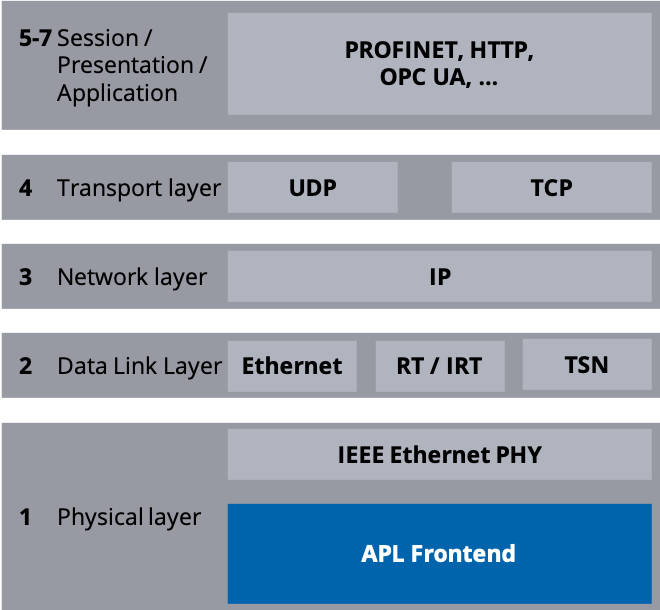
APL is an exciting new technology enabling intrinsically safe Ethernet connectivity to instruments in hazardous areas. Watch this video for a brief overview.
APL communicates via a cable length of up to 1000 m at 10 MBit/s, full-duplex, which is more than 300 times faster than current technologies, such as HART communication. It is the logical extension for Ethernet that provides the attributes required for reliable operation in the field of a process plant.
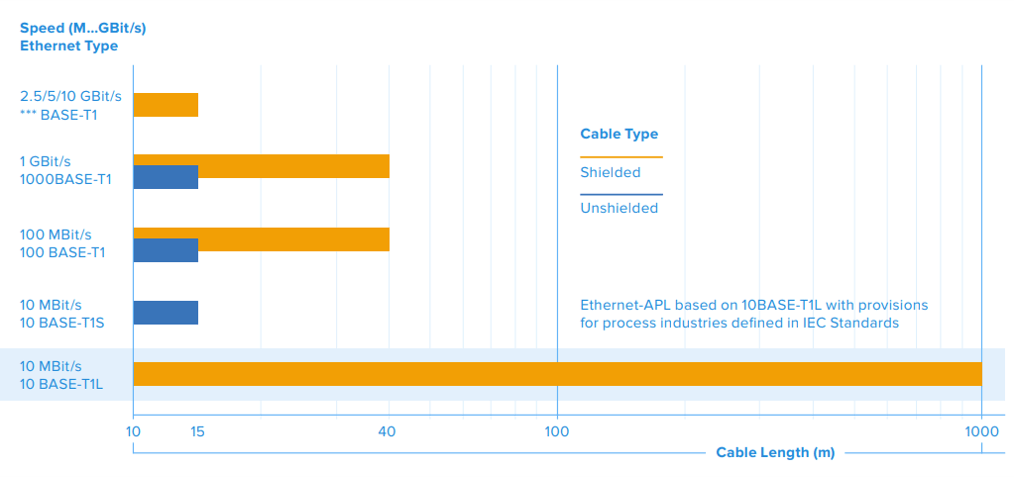
APL is an enhanced physical layer for single-pair Ethernet (SPE) based on 10BASE-T1L.
APL Topology
The APL switched architecture eliminates any unwanted interference between devices connected to the same network. The main goal is to adopt proven technologies and options in the field of process automation. The general topology will be based on the well-know Trunk-and-Spur configuration.
Trunk
- Mechanical methods such as increased safety transfer the maximum specified power into the hazardous area.
- Installation in hazardous areas, up to Zone 1, Div 1
- Cable length <= 1000m @ 10 Mbps full-duplex
Spur
- Intrinsic safety is supported at the spur.
- Installation in hazardous areas, up to Zone 0, Div 1
- Cable length <= 200m @ 10 Mbps full-duplex
- Intrinsic Safety verification similar to FISCO
- 2-wire, shielded IEC61158 type A fieldbus cable
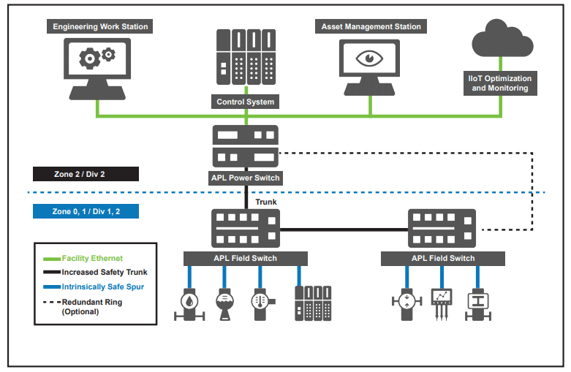
APL Technical Attributes
